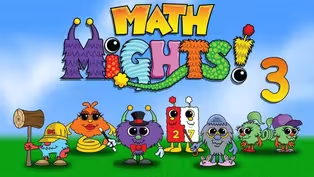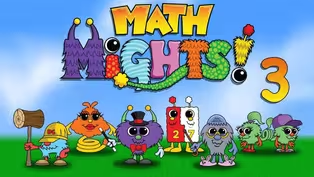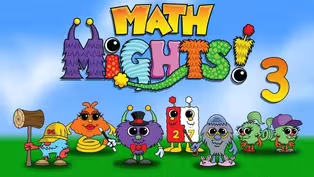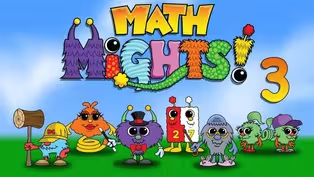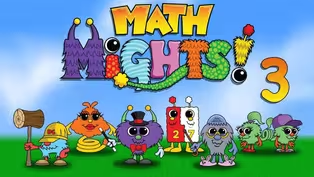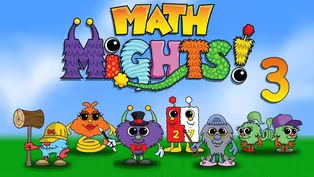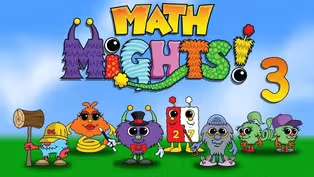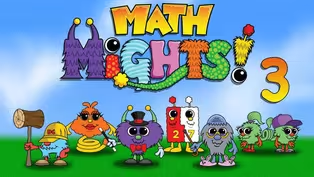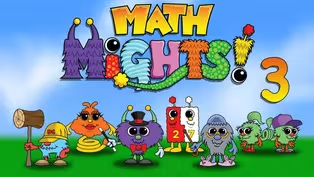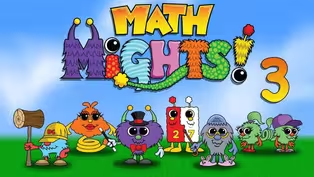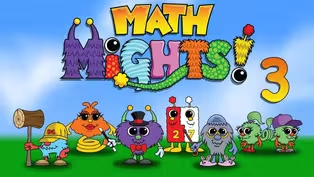Math Mights
Relating Multiplication and Division
Season 2 Episode 216 | 16mVideo has Closed Captions
Join Ms. Askew for a subtraction number talk with Springling!
Join Ms. Askew for a subtraction number talk with Springling! Get ready to learn how you can quickly multiply and divide by relating multiplication and division.
Problems playing video? | Closed Captioning Feedback
Problems playing video? | Closed Captioning Feedback
Math Mights is a local public television program presented by Detroit PBS
Math Mights
Relating Multiplication and Division
Season 2 Episode 216 | 16mVideo has Closed Captions
Join Ms. Askew for a subtraction number talk with Springling! Get ready to learn how you can quickly multiply and divide by relating multiplication and division.
Problems playing video? | Closed Captioning Feedback
How to Watch Math Mights
Math Mights is available to stream on pbs.org and the free PBS App, available on iPhone, Apple TV, Android TV, Android smartphones, Amazon Fire TV, Amazon Fire Tablet, Roku, Samsung Smart TV, and Vizio.
Providing Support for PBS.org
Learn Moreabout PBS online sponsorshipMore from This Collection
Video has Closed Captions
Join Ms. Askew for a tricky multi-step word problem with Professor Barble! (15m 59s)
Build Fraction from Unit Fractions
Video has Closed Captions
Join Ms. Askew for another multi-step word problem with Professor Barble! (15m 59s)
Video has Closed Captions
Join Ms. Askew for a division word problem with her friend Professor Barble. (15m 59s)
Video has Closed Captions
Join Ms. Askew for a division word problem with her friend Professor Barble. (16m)
Video has Closed Captions
Join Ms. Askew and Professor Barble to do a visual model with a word problem. (15m 59s)
Dividing with even larger numbers
Video has Closed Captions
Join Ms. Askew and Professor Barble to do a visual model with multiplication. (15m 59s)
Video has Closed Captions
Join Ms. Askew and Professor Barble to see if you can match visual models to word problems (15m 59s)
Dividing with Larger Quotients
Video has Closed Captions
Join Ms. Askew and Professor Barble to see if you can match visual models to word problems (15m 59s)
Video has Closed Captions
Learn about multiplying one-digit whole numbers by multiples of 10. (15m 59s)
Video has Closed Captions
Learn about multiplying numbers larger than 20. (16m)
Video has Closed Captions
Join Mrs. Askew for a Number Talk with 2 Math Might Friends! (16m)
Multiply Teen Numbers with Larger Groups
Video has Closed Captions
Join Mrs. Askew for a Number talk with 2 Math Might Friends! (15m 59s)
Providing Support for PBS.org
Learn Moreabout PBS online sponsorship(cheerful music) (spring boings) (glass squeaks) - [Children] Math Mights!
- Welcome back, third grade Math Might friends.
It's me, Ms. Askew, here again.
Are you ready to have some fun with math?
First, let's check out our plan for today.
We're gonna start with our Number Talk with our friend Springling, and then we're gonna learn more about relating multiplication and division.
First, we're gonna warm up our brains with a Number Talk.
Remember, a Number Talk is when you use different strategies to solve the same problem.
I wonder who's gonna help us solve this problem today.
Who would it be?
Who's our Math Might friend?
It looks like it's gonna be Springling.
Springling is a Math Might friend who was born in the city of Mathville.
She has fancy eyelashes, fluffy fur, but most importantly, she has a coily tail.
She likes to use that coily tail to hop forward and backwards on an open number line.
She likes to hop using friendly numbers in chunks.
She likes the count by 10, 20, 30.
She doesn't like to count one by one because then she can't use her coily tail, which she absolutely loves to use.
If you look at Springling, she has a secret.
That secret is she likes to carry plus balloons, because she likes to count and keep track of the number of hops she takes on the open number line.
Let's see what problem Springling has for us today.
118 minus 89.
I wonder how we're going to solve that problem.
Hmm, let's think about that.
What would Springling do?
Well, we know that Springling likes to take hops on a number line, so we're gonna think about that.
Let's see what Kavon does to solve that problem.
118 minus 89 equals 29.
It looks like Kavon started at 89 and he hopped to 90.
Let's take a closer look and see how he solved that problem.
I already have my number line set up.
We're gonna start at 89, and we want to end at 118.
We're gonna find out how far it is from 89 to 90.
Hop, Springling, hop.
It's one.
Now that we're at 90, we want to get to 100.
How far is it from 90 to 100?
Let's find out.
Hop, Springling, hop.
It's 10.
Now that we're at 100, we want to get to 118.
How far is it from 100 to 118?
Hop, Springling, hop.
It's 18.
Now let's add our numbers together.
1 plus 10 plus 18 equals 29.
So 118 minus 89 equals 29.
Let's see how Kate solved the problem 118 minus 89 equals 29.
It looks like Kate started at 89, and she took a great big hop to 99.
Let's take a closer look at how Kate solved the problem.
I already have my number line prepared.
89, and we're gonna end at 118.
First Kate started at the number 89 and she took one big hop to 99.
How far is it from 89 to 99?
It's 10.
Now that she's at 99, she wants to get to 100.
How far is it from 99 to 100?
Hop, Springling, hop.
It's 1.
Now that we're at 100, we want to get all the way to 118.
How far is it from 100 to 118?
Hop, Springling, hop.
It's 18.
Now let's add our numbers together.
10 plus 1 plus 18 equals 29.
118 minus 89 equals 29.
Wasn't it interesting to see how Kate and Kavon both used friendly numbers to solve the problem?
They both used 10, 1, and 18, using those friendly numbers just like Springling taught us.
How did you choose to solve the problem?
Okay, boys and girls.
Let's look at our I can statement for the day.
I can multiply and divide easily and quickly because I know how multiplication and division are related.
Let's look at these three expressions, and think about it mentally.
What do you notice?
Kate sees the problem four groups of 10, or four times 10, and says that the answer is 40.
I count 10, 20, 30, 40.
I just knew it.
Kavon sees the problem 40 divided by 4 equals 10.
Since I know that 4 times 10 equals 40, I know that 40 divided by 4 is 10, because 10 would be the missing factor.
Connor sees the problem 40 divided by 10 equals 4.
This is just like 40 divided by 4, but the other factor is missing, so the quotient would be 4.
Isn't it interesting how all of our friends did a great job of solving those problems mentally?
And did you notice that all of those problems had the same numbers?
We're gonna go and take a closer look and see how multiplication and division are related.
Let's take a look at this array.
Can you come up with two multiplication and two division equations to match the picture?
Let's look at the problem.
Four groups of five equals 20.
We're gonna act it out on our whiteboard.
Let's write out the problem.
Four groups of five equals 20.
The first factor is how many groups, or how many rows?
Four.
One, two, three, four.
The second factor represents how many are in each row.
One, two, three, four, five.
Because we have five in each row, we can skip count by five to reach our product or answer.
Let's try it.
5, 10, 15, 20.
So four groups of five equals 20.
Now let's look at the division problem 20 divided by four equals five.
How can we solve that?
Let's act it out on our whiteboard.
We know that we have 20 total.
That's our total amount of tiles.
We're going to divide it by four equal groups.
One, two, three, four.
How many are in those four equal groups?
One, two, three, four, five.
So that means 20 divided by four equals five.
See how those two problems are related?
Let's turn our array a different way, and see if we can come up with a second multiplication problem.
We see now that five groups of four equals 20.
Let's act it out on our white board.
The first factor, five, is how many roles we have.
The second factor, four, represents how many are in each row.
Let's count the rows.
One, two, three, four, five.
Let's count how many are in each row.
One, two, three, four.
Now let's see what five groups of four equals.
Let's skip count by fours.
4, 8, 12, 16, 20.
Five groups of four equals 20.
Now we're gonna find our second division problem, 20 divided by five equals four.
Let's take a look on our whiteboard.
First, we're gonna start with our total, or our dividend, which is 20, the entire or total number of tiles that we have.
Then we're gonna divide it into five equal groups.
Let's see how many are in each group.
One, two, three, four, five groups, and one, two, three, four in each group.
So 20 divided by five equals four.
Now that you have a better understanding of how multiplication and division are related, let's play a game called If I Know, Then I Know.
If I know three groups of five equals 15, I see three rows with five in each row.
If I know three groups of five equals 15, then I know 15 divided by three equals five.
I see 15 total, and I see three rows.
There are five in each row.
So 15 divided by three equals five.
All right, boys and girls, let's try another problem to make sure we understand it very well.
If you look at our problem, we have, if I know four groups of six equals 24, we're gonna model what that would look like on our whiteboard to make sure we fully understand what that means.
As you can see on our whiteboard, I've already started creating our rows.
Remember, the first factor in the equation represents how many rows, or how many groups.
One, two, three, four.
The second factor represents how many are in each group or row.
Now I'm going to fill in with the rest of my squares.
Now we have six in the first row, one, two, three, four, five, six.
I'm going to continue filling in my squares until I have completed the equation.
Now we have it.
Four rows, one, two, three, four.
Six in each row, one, two, three, four, five, six, which equals a total of 24.
Four groups of six equals 24.
Okay, boys and girls, like we just saw on the white board, four groups of six equals 24.
Playing our game, we can then say, then I know if I have a total of 24, and I put them into four rows, how many will be in each row?
Let's use our whiteboard and take a closer look.
Now, boys and girls, we have our total of 24, which is the dividend, and we're going to divide them into four equal groups, one, two, three, four.
If we want to find out what the quotient is, we are going to circle each of those four groups.
Now how many are in each group?
One, two, three, four, five, six.
So the total 24 divided into those four groups gives us six in each group.
24 divided by four equals six.
If you take those same two factors, the four and the six, and we turn them around, we can make another fact family.
If you know that six groups of four equals 24, then I know 24 divided by six equals four.
We've learned a lot about multiplication and division today, but as third graders, that can be a lot of information.
Today, we're gonna help you practice by making a fact flap card.
Sometimes when we practice, we use lots of cards, flashcards, 20, 30, multiple cards.
This activity is gonna take those flashcards and turn them into one easy card that you can use to help you practice.
Let's take a look at the materials that we will need.
You will need a pair of scissors, something to write with, and a piece of paper, or you can use the template that I'm going to use today.
The first thing that we're gonna do is cut our card, or this piece of paper, into five sections.
Make sure you cut along the dotted line, but don't go all the way.
Now, we're gonna number them in random order, one through 10.
We want them to be in random order, because we don't want to just memorize our facts.
We want to make sure we know them.
So begin to number them.
One, two, three, four, five, six, seven, eight, nine, 10.
Next, we're gonna put what our groups will be.
We're gonna be multiplying by groups of three.
Let's start finding our answers.
Three groups of one equals three, so we're gonna fold our flap over, and we're gonna write the answer, three.
Next, three groups of four equals 12.
Fold your flap over and write the number 12.
Now I'm going to continue to write the answers.
Now that you're on the multiplication side, make sure you use the math stem, blank groups of blank equals blank.
We can practice that by saying one group of three equals three, four groups of three equals 12, nine groups of three equals 27, 10 groups of three equals 30.
Now comes the magical part.
When you flip your card over, you already have your division.
So now we're gonna practice dividing by three.
When you're on the division side, make sure you use the math stem blank into blank groups is blank.
Now let's try it out.
21 into three groups is seven.
12 into three groups is four.
18 into three groups is six.
27 into three groups is nine.
Now it's your turn to make your fact flap cards to practice multiplication and division.
Thanks for joining us, third grade Math Mights.
We had so much fun with multiplication and division.
I hope to see you soon where we can practice some more.
(cheerful music) (playful whistling music) - [Announcer] SIS4Teachers.org.
Changing the way you think about math.
- [Announcer] This program is made possible with funding from the Michigan Department of Education Governor's Education Emergency Funds, the state of Michigan, and by viewers like you.


- Home and How To

Hit the road in a classic car for a tour through Great Britain with two antiques experts.










Careers that Work

Support for PBS provided by:
Math Mights is a local public television program presented by Detroit PBS
